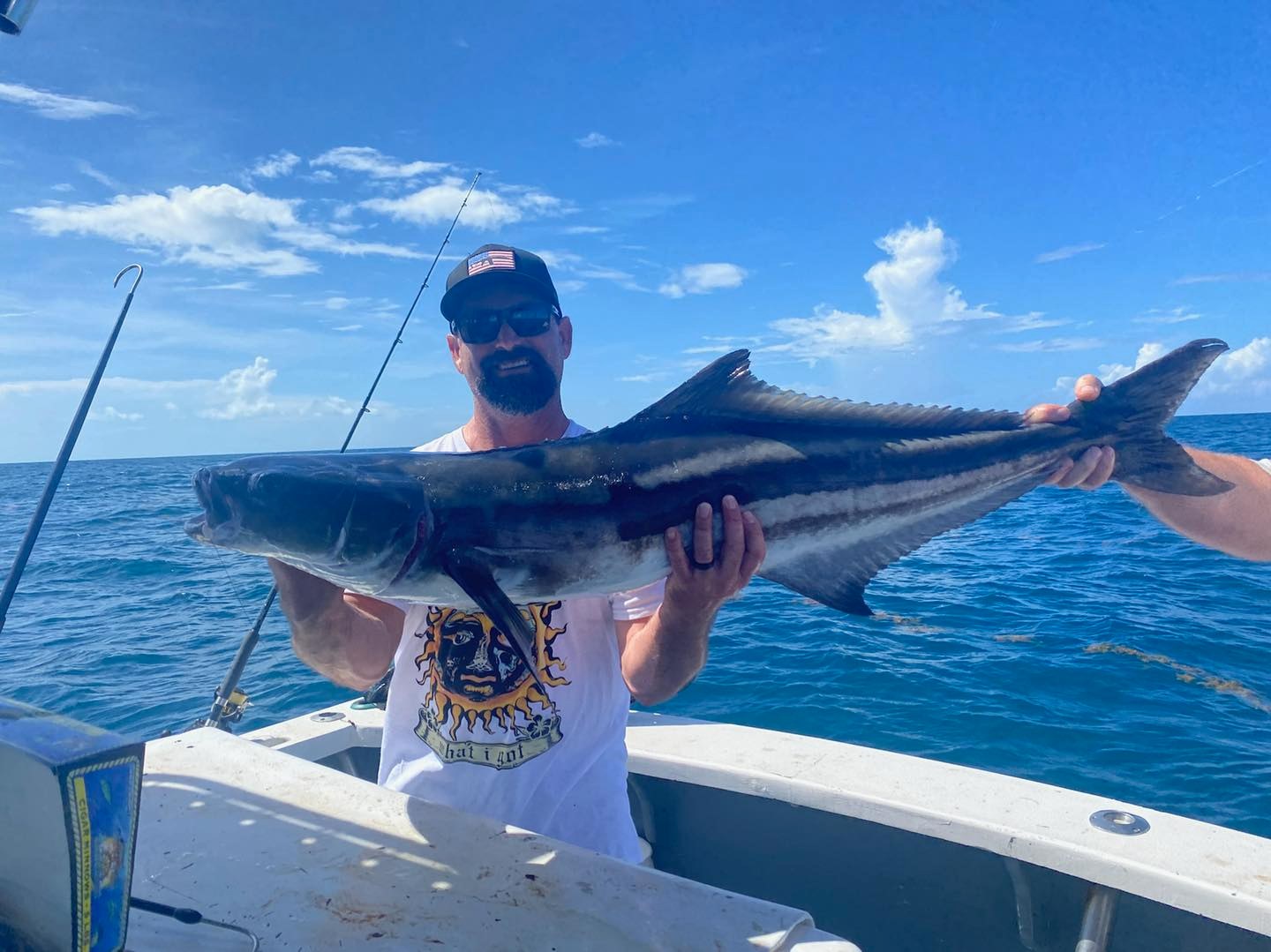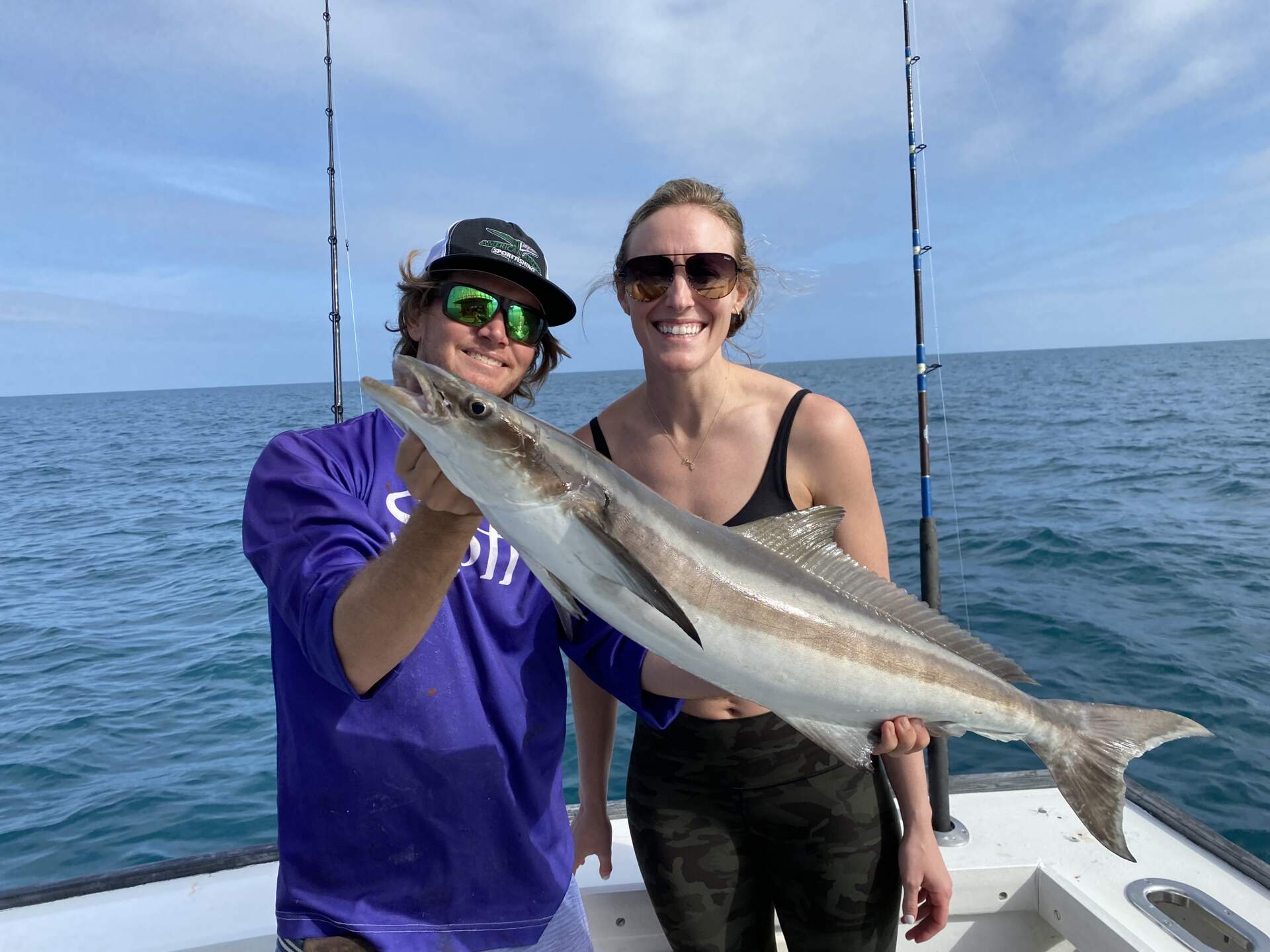Last Updated on March 28, 2025 by Eric
Cobia are among the most sought-after migratory species during spring along Florida’s Atlantic coast, and Cape Canaveral offers one of the most consistent opportunities to target them. Known for their size, strength, and unpredictable fights, cobia begin moving through the region in large numbers as water temperatures rise in spring. This guide provides a comprehensive overview of cobia behavior, springtime movement patterns, productive areas near Cape Canaveral, and the gear and techniques needed for a successful day on the water with Canaveral Kings.
Detailed Species Description: Cobia
Cobia (Rachycentron canadum) are long, muscular fish with a dark brown to bronze upper body and a white belly. They are often mistaken for sharks at first glance due to their shape and swimming posture. A broad head, low dorsal fin, and powerful tail give them the strength and stamina that make them a standout target among local fishermen. Average cobia range from 20 to 50 pounds, though fish exceeding 60 pounds are not uncommon in this region.
They are opportunistic feeders, preying on eels, crabs, pinfish, and other small baitfish. Cobia are commonly found alone or in small groups and are often observed trailing large rays, sea turtles, or floating debris, especially in clean water during spring.

Seasonal Patterns off Cape Canaveral
Spring marks the peak of the cobia migration along Florida’s east coast. As nearshore and offshore water temperatures climb into the 68°F to 75°F range, cobia move northward from southern Florida, arriving in numbers off Cape Canaveral between late March and early May.
This seasonal shift aligns with increased bait activity and calmer sea conditions, creating ideal opportunities for both sight fishing and structure-based targeting. Cobia are highly visible during this period, often cruising just below the surface or hovering near navigation buoys, rays, and color breaks where bait collects. Their movement through the area is relatively fast, so conditions can change daily, making local experience and timing especially valuable.
Locating Cobia in Spring
Cobia are most often found near transitional structures or visible surface activity during the spring migration. Productive areas off Cape Canaveral include:
Manta Rays and Large Surface Shadows
One of the most reliable signs of spring cobia is the presence of manta rays. Cobia often swim directly behind or alongside these rays, using them for cover while hunting bait. Watching for dark shapes just under the surface is a common method used by experienced fishermen during calm conditions.
Buoys, Channel Markers, and Navigation Towers
Cobia are known to hold around nearshore buoys and towers, especially in areas with tidal flow or bait concentration. These locations offer short-range sight casting opportunities and are often visited multiple times during a trip.
Color Breaks and Temperature Changes
Areas where clean blue water meets stained green water can create natural feeding zones. Cobia are frequently seen working these transition lines, especially when baitfish are stacked along the boundary.
Wrecks and Reefs
When not cruising near the surface, cobia can be found staging over offshore wrecks and reef structures. Vertical jigging or dropping live bait over these areas often produces strikes from fish holding deeper in the water column.

Recommended Gear and Tackle Setup
Targeting cobia requires gear that can handle heavy runs, unpredictable angles, and fish that may turn quickly back toward structure.
Rods and Reels
-
Rods: Medium-heavy action rods between 7 and 8 feet in length offer the strength to control large fish while allowing long, accurate casts.
-
Reels: Spinning reels in the 6000–8000 size range, paired with strong drag systems, provide the power needed for both casting and fighting cobia in open water.
Line and Leaders
-
Main Line: 40–65 lb braided line gives the best combination of strength, casting distance, and sensitivity.
-
Leader: Use a 40–60 lb fluorocarbon leader of 2 to 4 feet. Cobia aren’t typically line-shy, but they are strong and often roll during the fight, making abrasion resistance essential.
Best Baits and Lures for Cobia
Cobia feed aggressively during spring and respond well to a variety of live baits and artificial offerings.
Live Bait
-
Eels: A preferred bait when available, rigged on a single circle or J-hook and presented near structure or cast toward visible fish.
-
Live Pinfish or Croakers: Dropped around wrecks or suspended below floats near buoys, these baits attract strikes from fish holding below the surface.
-
Live Pilchards or Threadfin Herring: Particularly effective when slow-trolled or drifted near visible structure or color breaks.
Artificial Lures
-
Large Bucktail Jigs: White, chartreuse, or pink bucktails rigged with soft plastic trailers are a standby for sight casting.
-
Swimbaits: Paddle tail swimbaits on heavy jigheads allow for fast presentation when fish are moving.
-
Topwater Plugs: In calm water, a well-placed topwater plug can draw explosive strikes from cobia cruising near the surface.
-
Metal Jigs: Vertical jigs or casting spoons can be worked over structure when fish are not visible at the surface.
Techniques for Catching Cobia
Sight Casting
During the migration, sight fishing is the most productive and exciting method. Fishermen scan the surface for rays, shadows, or free-swimming cobia, then cast ahead of the fish’s path using jigs or live bait.
Drifting and Slow Trolling
Over reefs, wrecks, or along color lines, drifting with live bait or trolling slowly with natural or artificial offerings can help cover more water and locate less visible fish.
Vertical Jigging
When cobia are holding deeper, especially over wrecks or ledges, dropping heavy metal jigs or soft plastics and working them through the lower third of the water column can draw strikes.
Running Structure
Many fishermen make a circuit of known buoys, towers, and wrecks, checking each for visible fish or signs of activity. This method allows for targeted casting and efficient use of time when the surface bite is inconsistent.
Handling and Landing Cobia
Cobia fight with unpredictable power and often make late surges at the boat. Handling them safely requires preparation:
-
Use a large, rubber-coated landing net when possible.
-
If using a gaff, ensure the fish is clearly legal before committing. Cobia are known to thrash violently on deck.
-
Wear gloves when handling and always support the body weight of the fish.
-
Immediately place harvested fish on ice to maintain quality.
Safety and Regulations
Before heading out, check the current regulations for cobia in Atlantic state waters, as rules have been updated in recent years.
-
Minimum size: 36 inches fork length
-
Bag limit: 1 cobia per person per day
-
Vessel limit: No more than 2 fish per vessel per day
-
Licensing: Ensure all state licenses are current and review any additional federal guidelines for offshore trips.
These regulations are subject to change, and enforcement is strict, especially during peak migratory periods.

Putting the Spring Pattern to Work for Cobia
Targeting cobia in spring off Cape Canaveral gives fishermen one of the most exciting seasonal opportunities on Florida’s Atlantic coast. From sight casting to manta rays to working offshore wrecks, the combination of fish size, aggressive feeding behavior, and migratory timing makes this species a top priority during the season.
At Canaveral Kings, our captains are on the water daily throughout the spring migration and bring the local knowledge needed to put you on fish quickly and effectively. Whether you’re new to cobia fishing or looking to sharpen your technique, we offer tailored trips that take advantage of seasonal patterns and real-time conditions. Book your spring trip today and experience the peak of cobia season off the Cape.

